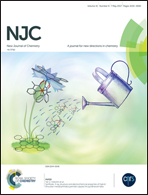MoOx–pyridine organic–inorganic hybrid wires as a reusable and highly selective catalyst for the oxidation of alcohols: a comparison study between reaction-controlled phase-transfer catalysis and heterogeneous catalysis†
Abstract
The different catalytic behaviors of Mo3O10(C5H6N)2·H2O wires (MoOx–pyridine) in the selective oxidation of alcohols by means of molecular oxygen (O2) and hydrogen peroxide (H2O2) as green oxidants were investigated. These hybrid wires were fabricated by an easy wet chemical method under mild conditions and the fresh catalyst was characterized by different methods. Using molecular oxygen as an oxidant, the reaction progressed via the highly reusable heterogeneous system at a mild temperature. Notably, when hydrogen peroxide was employed, alcohols were efficiently oxidized to the corresponding ketones or aldehydes through reaction-controlled phase-transfer catalysis under solvent-free conditions. The catalyst formed soluble-active species and acted like a homogeneous system. Eventually the catalyst easily precipitated for simple recycling when hydrogen peroxide was completely consumed. Consequently, the benefits of both heterogeneous and homogeneous catalysts were combined into one system.



 Please wait while we load your content...
Please wait while we load your content...